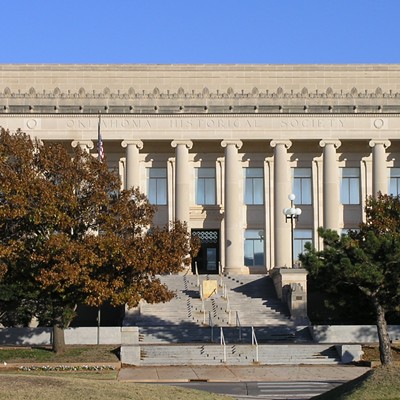Bob Blackburn, executive director of the Oklahoma Historical Society, said the Civil War events that occurred in Indian Territory were dramatic after the clock started ticking in 1803 with the Louisiana Purchase.
“It all changes directions from 1861 to 1865 for the Indians, and for the African-Americans who had been victims of slavery. It changed the economy of the South; it changed the relationship of the Indian tribes and the federal government,” Blackburn said. “We’re still being affected by those changes today.”
Take Oklahoma State University, for example.
Cal Kinzer, history instructor in the Arts and Sciences Division at OSU Institute of Technology, noted that President Abraham Lincoln signed the 1862 Morrill Act, which led to land grant colleges and OSU.
“(The Civil War) allowed the railroads in, so economic history changes,” Blackburn said. “With allotment, Indians finally get mineral rights, so that opens up the possibility of oil and gas. The statehood process itself was set in motion after the Civil War. I can take any part of our history today — urban history, economic history, oil, land, gas — it goes on and on. I can show a direct line back to the consequences of the Civil War.”
Blackburn said Indian Territory’s most unique Civil War moment involved the First Kansas Colored Regiment at the Battle of Honey Springs. The engagement near Checotah is the largest military clash to occur within the state’s modern-day borders, with approximately 9,000 men involved, according to the Oklahoma Historical Society.
Like the 54th Massachusetts Volunteer Infantry Regiment that stormed Fort Wagner, as depicted in the 1989 film “Glory,” the Honey Springs regiment was one of the first official black units in the U.S. during the Civil War. Both had their first major engagements in July of 1863.
“The Union won that day
largely because of the bravery and discipline of the First Kansas
Colored Regiment,” Blackburn said of Honey Springs.
“And they were literally fighting for their freedom, not just for a
cause, not for state’s rights. They weren’t fighting to protect the
Union.”
‘INDIAN MET INDIAN’
Indian
Territory saw more death and destruction during the Civil War, per
capita, than the state of Virginia, Blackburn said. Fighting was vicious
in the territorial crossroads between Confederate Texas and Arkansas
and Union Kansas and Missouri, with the Texas Road trade route and
navigable Arkansas River serving as virtual superhighways.
“You
not only had the North fighting the South; you had tribal members
fighting each other,” Blackburn said. “We were kind of the borderland.
If anyone was going to fight in another region, they had to come
across.”
Two weeks
after Gettysburg and Vicksburg in summer of 1863, Union troops trudged
through rainfall as control of land west of the Mississippi River was
hanging in the balance. In the rolling prairie roughly 116 miles east of
modernday Oklahoma City, Union soldiers halted behind a ridge as
Confederate troops hid among Elk Creek.
“At
the Battle of Honey Springs, Indian met Indian,” Charles R. Freeman
wrote in “Chronicles of Oklahoma.” Civil War sympathies were divided in
Indian Territory among the relocated tribes. More conservative tribal
members viewed slaveholding as an accommodation to Euro-American culture
and tended to support the Union, according to T.
Lindsay Baker and Julie P. Baker in “The WPA Oklahoma Slave Narratives.”
Maj.
Gen. James G. Blunt guided Union soldiers from Kansas, Colorado and
Wisconsin fighting alongside Indian Home Guard volunteer infantry
regiments. Meanwhile, Brig. Gen. Douglas H. Cooper commanded Confederate
forces, which consisted of Texas soldiers along with Cherokee, Creek,
Choctaw and Chickasaw warriors.
The
uniquely diverse Battle of Honey Springs marked one of the first times
black, Native American and Caucasian troops fought together against
Confederate forces, which also included indigenous troops, said Cody
Jolliff, coordinator of the Oklahoma Civil War Sesquicentennial.
A
Confederate commissary depot was located at Honey Springs, a well-known
resting place along Texas Road. Prior to battle, Cooper established
headquarters alongside the heavily timbered Elk Creek, according to
Freeman. When Blunt learned that Brig. Gen. William L. Cabell and his
men would be joining Cooper’s forces, Union forces pushed forward to
attack before Cabell reached Honey Springs, Freeman wrote. Cabell and
his soldiers arrived one day later.
Blunt forced engagement immediately on July 17, 1863.
“The
cannonading commenced and the battle on the north of the creek was
furious for a few hours, finally driving Cooper’s men back across Elk
Creek,” Freeman wrote.
VICTORY OVER SLAVERY
The
first test of black soldiers west of the Mississippi River, Honey
Springs determined whether they would fight in direct combat, according
to author Nancy C. Curtis in “Black Heritage Sites: An African-American
Odyssey and Finder’s Guide.”
“The
black men were assigned to fight off Texans who were protecting their
borders from federal forces,” Curtis wrote. “The African-Americans were
placed in front center of Union lines, Native Americans were placed on
either side of the black men and white soldiers, in general, were at the
rear. Native Americans also were fighting on the Confederate side.”
After the black troops halted the Confederate charge, they had to make a decision whether to engage or flee, Blackburn said.
“And they looked at each
other on their ranks, and they said, ‘We’re gonna fight,’” he said. “And
they stayed, they reloaded, they fired again and stopped the charge,
and won the battle in that 20 seconds.”
The black soldiers were welltrained for European-style warfare, according to Curtis.
“They
had an added incentive to win because they had been told they would be
made slaves if they were captured,” she wrote. “The African- Americans
fought superbly.”
The Native Americans, accustomed to guerilla-style warfare, relied on concealment and surprise, Curtis wrote.
“The
odds were all against Cooper from the start and … the material
equipment proved itself inadequate indeed,” according to “The American
Indian as Participant in the Civil War” by Annie Heloise Abel. “Much of
the ammunition was worthless. Nevertheless, Cooper stubbornly contested
every inch of the ground and finally gave way only when large numbers of
his Indians, knowing their guns to be absolutely useless to them,
became disheartened and then demoralized.”
In
a report filed July 26, 1863, Blunt wrote that the gallant black
soldiers fought like veterans, preserving an unbroken line throughout
the engagement.
“Their
coolness and bravery I have never seen surpassed; they were in the
hottest of the fight, and opposed to Texas troops twice their number,
whom they completely routed,” Blunt wrote. “One Texas regiment (the 20th
Cavalry) that fought against them went into the fight with 300 men and
came out with only 60.”
HISTORICAL CONTEXT
Efforts are under way to
preserve Indian Territory’s battlefields from the war that affected
everyone, Blackburn said. The OHS owns the following sites: Honey
Springs Battlefield, Fort Gibson Historic Site, Fort Towson Historic
Site, Fort Washita Historic Site and the George Murrell Home.
“We’ve tried to develop
and sustain those over the years, and in current budget straits it’s
difficult, but we’re doing our best,” he said.
Education
is key to understanding the all-encompassing event. Blackburn said two
broad African-American communities exist in Oklahoma because of the
Civil War.
“You have
descendants of former slaves among the Indian Territory,” he said. “And
it was a different kind, a brand of slavery. It was still cruel and
inhumane, but there was more intermarriage in the Indian culture. There
is a distinct Indian stream within African-American culture of those
former slaves and then their descendants.
“The other group of African- Americans in Oklahoma are those who came out of old South after 1898.”
Since
the federal government forced Indian tribes to recognize the former
slaves, they received land during the allotment, Blackburn said. The
ongoing Cherokee freedmen dispute making headlines is one example.
“Blood
quantum is one issue; the other is treaty stipulation,” he said. “And
the federal government forced these treaties on the Indians, saying that
you will recognize the former slaves that are descendants as members of
the tribe in terms of land. The federal government thought Indian
nations were going away.
“You can see why there’s a lot of confusion today over that issue.”
HONEY SPRINGS RE-ENACTMENT
A
Battle of Honey Springs re-enactment will be the keynote event in the
Oklahoma Civil War Sesquicentennial Commission’s programming planned for
the next four years.
Cody
Jolliff, coordinator of the Oklahoma Civil War Sesquicentennial, said
the battlefield is being cleared of overgrowth to prepare for the
reenactment April 29 to May 1.
“Friday
is an education day with stations being set up to explore different
topics of the battle, such as Cavalry, artillery and infantry troops,
Civil War field music, medicine, refugees, etc.,” Jolliff said.
Saturday
and Sunday events will provide short lectures, and a battle
re-enactment will take place for the visiting public, said John Davis,
director of the Honey Springs Battlefield.
“The
public will also have the opportunity to visit both Union and
Confederate camps and period sutlers that will be on site for the
event,” Davis said. “There will be several modern-food vendors and
informational booths for the visiting public.” —Rob Collins
View a published report of the Battle of Honey Springs and a battle map.








